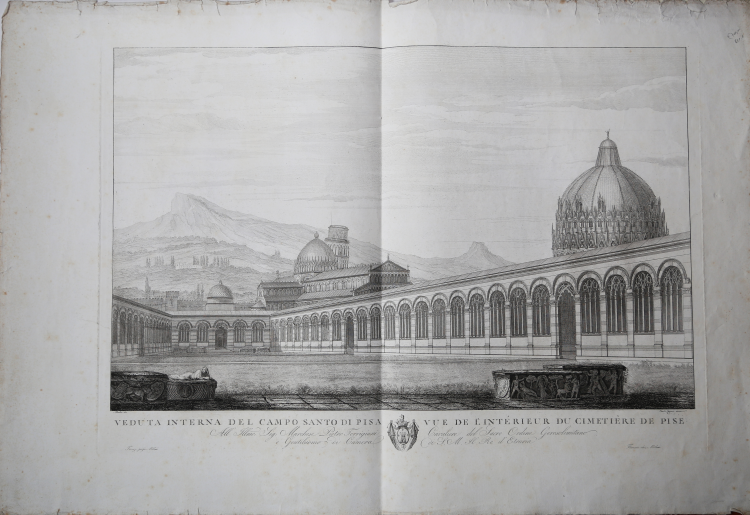


| Reference: | MS8355 |
| Author | Carlo LASINIO |
| Year: | 1828 |
| Zone: | Pisa |
| Printed: | Florence |
| Measures: | 650 x 515 mm |


| Reference: | MS8355 |
| Author | Carlo LASINIO |
| Year: | 1828 |
| Zone: | Pisa |
| Printed: | Florence |
| Measures: | 650 x 515 mm |
Spectacular view of the monumental Campo Santo in Pisa, with the Duomo and the Tower, taken from the Pitture a fresco del Campo Santo di Pisa, published in Florence in 1828.
Copperplate, good condition.
Carlo LASINIO (Treviso 1759 - Pisa 1838)
|
Lasinio started as a painter at the Accademia, Venice. He quickly placed more emphasis on printmaking, especially after moving to Florence in 1778. Lasinio moved to Pisa in 1807, taking up the position of conservatore of the Camposanto. He made considerable efforts to protect the Camposanto and its frescoes from ruin, from which it was threatened due to the destructive effects of the Napoleonic wars. In 1812 he began his influential book of etchings, recording the frescoes in the Camposanto. This was entitled, Pitture a fresco del Camp Santo di Pisa. These large etchings were composed in the sharply defined "outline style", which was popular in the early nineteenth century in reaction to the soft tonal effects of 18th century stipple engravers such as Francesco Bartolozzi. Other works depicting the old masters included his forty plates of Frescoes and Oil Paintings at Florence (1789), large etchings which delineated the most famous Renaissance frescoes in Florence; and thirty-two plates of Frescoes of the Fourteenth and Fifteenth Centuries.
Among his other activities Lasinio also founded the Academy in Pisa, where he died. Apart from his many series of engravings and etchings, Lasinio also created original images. His portrayals of eminent Italians include the great explorers, Christopher Columbus and Amerigo Vespucci.
His son, Giovanni Paolo Lasinio, was also an engraver.
|
Carlo LASINIO (Treviso 1759 - Pisa 1838)
|
Lasinio started as a painter at the Accademia, Venice. He quickly placed more emphasis on printmaking, especially after moving to Florence in 1778. Lasinio moved to Pisa in 1807, taking up the position of conservatore of the Camposanto. He made considerable efforts to protect the Camposanto and its frescoes from ruin, from which it was threatened due to the destructive effects of the Napoleonic wars. In 1812 he began his influential book of etchings, recording the frescoes in the Camposanto. This was entitled, Pitture a fresco del Camp Santo di Pisa. These large etchings were composed in the sharply defined "outline style", which was popular in the early nineteenth century in reaction to the soft tonal effects of 18th century stipple engravers such as Francesco Bartolozzi. Other works depicting the old masters included his forty plates of Frescoes and Oil Paintings at Florence (1789), large etchings which delineated the most famous Renaissance frescoes in Florence; and thirty-two plates of Frescoes of the Fourteenth and Fifteenth Centuries.
Among his other activities Lasinio also founded the Academy in Pisa, where he died. Apart from his many series of engravings and etchings, Lasinio also created original images. His portrayals of eminent Italians include the great explorers, Christopher Columbus and Amerigo Vespucci.
His son, Giovanni Paolo Lasinio, was also an engraver.
|